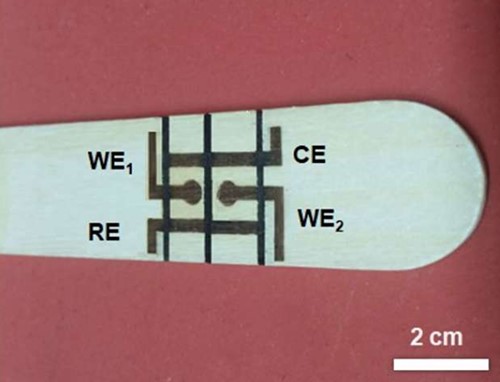University of Athens Researchers Create Wooden Tongue Depressor with Biosensing Capabilities Capable of Identifying Biomarkers
Scientists believe the biodegradable device could someday help detect multiple saliva biomarkers. If true, it might provide a new type of test for clinical laboratories
When it comes to tongue depressors, it turns out you can teach an old dog new tricks. Researchers from National and Kapodistrian University of Athens Greece (NKUA) have taken this simple wooden medical tool and developed a high-tech biosensing device that may someday be useful at the point-of-care in hospitals and as a new type of test for clinical laboratories.
Using diode laser engraving, the researchers developed an “eco-friendly disposable sensor that can measure glucose levels and other biomarkers in saliva,” according to LabMedica.
This proof-of-principle biosensing device demonstrates the feasibility of “simultaneous determination of glucose and nitrite in artificial saliva,” according to the NKUA scientists who hope it will help doctors diagnose a variety of conditions.
The researchers published a paper on the development of their new wooden biosensor in the journal Analytical Chemistry titled, “Wooden Tongue Depressor Multiplex Saliva Biosensor Fabricated via Diode Laser Engraving.”

In their published paper, the scientists at the University of Athens wrote that their wooden electrochemical biosensing tongue depressor (above) “is an easy-to-fabricate disposable point-of-care chip with a wide scope of applicability to other bioassays,” and that “it paves the way for the low-cost and straightforward production of wooden electrochemical platforms.” Might this and other similar biosensing devices eventually find their way to clinical laboratories for use in identifying and tracking certain biomarkers for disease? (Photo copyright: University of Athens.)
How to Make a High-Tech Tongue Depressor
Though wood is affordable and accessible, it doesn’t conduct electricity very well. The researchers’ first attempt to solve this problem was to use the wood as “a passive substrate” to which they coated “metals and carbon-based inks,” LabMedica reported. After that they tried using high-powered lasers to “char specific regions on the wood, turning those spots into conductive graphite.” But that process was complicated, expensive, and a fire hazard.
The researchers eventually turned to “low-power diode lasers” which have been used successfully “to make polyimide-based sensors but have not previously been applied to wooden electronics and electrochemical sensors,” LabMedica noted.
In their Analytical Chemistry paper, the researchers wrote, “A low-cost laser engraver, equipped with a low-power (0.5 W) diode laser, programmably irradiates the surface of the WTD [wooden tongue depressor], forming two mini electrochemical cells (e-cells). The two e-cells consist of four graphite electrodes: two working electrodes, a common counter, and a common reference electrode. The two e-cells are spatially separated via programmable pen-plotting, using a commercial hydrophobic marker pen.”
In other words, the researchers “used a portable, low-cost laser engraver to create a pattern of conductive graphite electrodes on a wooden tongue depressor, without the need for special conditions. Those electrodes formed two electrochemical cells separated by lines drawn with a water-repellent permanent marker,” states a press release from the American Chemical Society.
“The biosensor was then used to quickly and simultaneously measure nitrite and glucose concentrations in artificial saliva. Nitrite can indicate oral diseases like periodontitis, while glucose can serve as a diagnostic for diabetes. The researchers suggest that these low-cost devices could be adapted to detect other saliva biomarkers and could be easily and rapidly produced on-site at medical facilities,” LabMedica reported.
Benefits of Using Wood
One of the major benefits of using wood for their biosensing device is how environmentally friendly it is. “Since wood is a renewable, biodegradable naturally occurring material, the development of conductive patterns on wood substrates is a new and innovative chapter in sustainable electronics and sensors,” the researchers wrote in Analytical Chemistry.
Additionally, the tongue depressor features “An easy-to-fabricate disposable point-of-care chip with a wide scope of applicability to other bioassays, while it paves the way for the low-cost and straightforward production of wooden electrochemical platforms,” the researchers added.
This adds to a growing trend of developing bioassay products that keep the health of our planet in mind.
In “University of Pennsylvania Researchers Use Cellulose to Produce Accurate Rapid COVID-19 Test Results Faster and Cheaper than Traditional PCR Tests,” we covered how researchers at the University of Pennsylvania (UPenn) had developed a biodegradable rapid COVID-19 test that uses bacterial cellulose (BC) instead of printed circuit boards (PCBs) as its biosensor.
“This new BC test is non-toxic, naturally biodegradable and both inexpensive and scalable to mass production, currently costing less than $4.00 per test to produce. Its cellulose fibers do not require the chemicals used to manufacture paper, and the test is almost entirely biodegradable,” a UPenn blog post noted.
New Future Tool Use in Clinical Diagnostics
Who could have predicted that the lowly wooden tongue depressor would go high tech with technology that uses lasers to convert it to an electrochemical multiplex biosensing device for oral fluid analysis? This is yet another example of technologies cleverly applied to classic devices that enable them to deliver useful diagnostic information about patients.
And while a biosensing tongue depressor is certainly a diagnostic tool that may be useful for nurses and physicians in clinic and hospital settings, with further technology advancements, it could someday be used to collect specimens that measure more than glucose and nitrites.
—Kristin Althea O’Connor
Related Information:
Wooden Tongue Depressor Multiplex Saliva Biosensor Fabricated via Diode Laser Engraving
Say ‘Ahhh’: This Ecofriendly Tongue Depressor Checks Vitals
Biosensor-Fabricated Wooden Tongue Depressor Measures Glucose and Nitrite in Saliva




